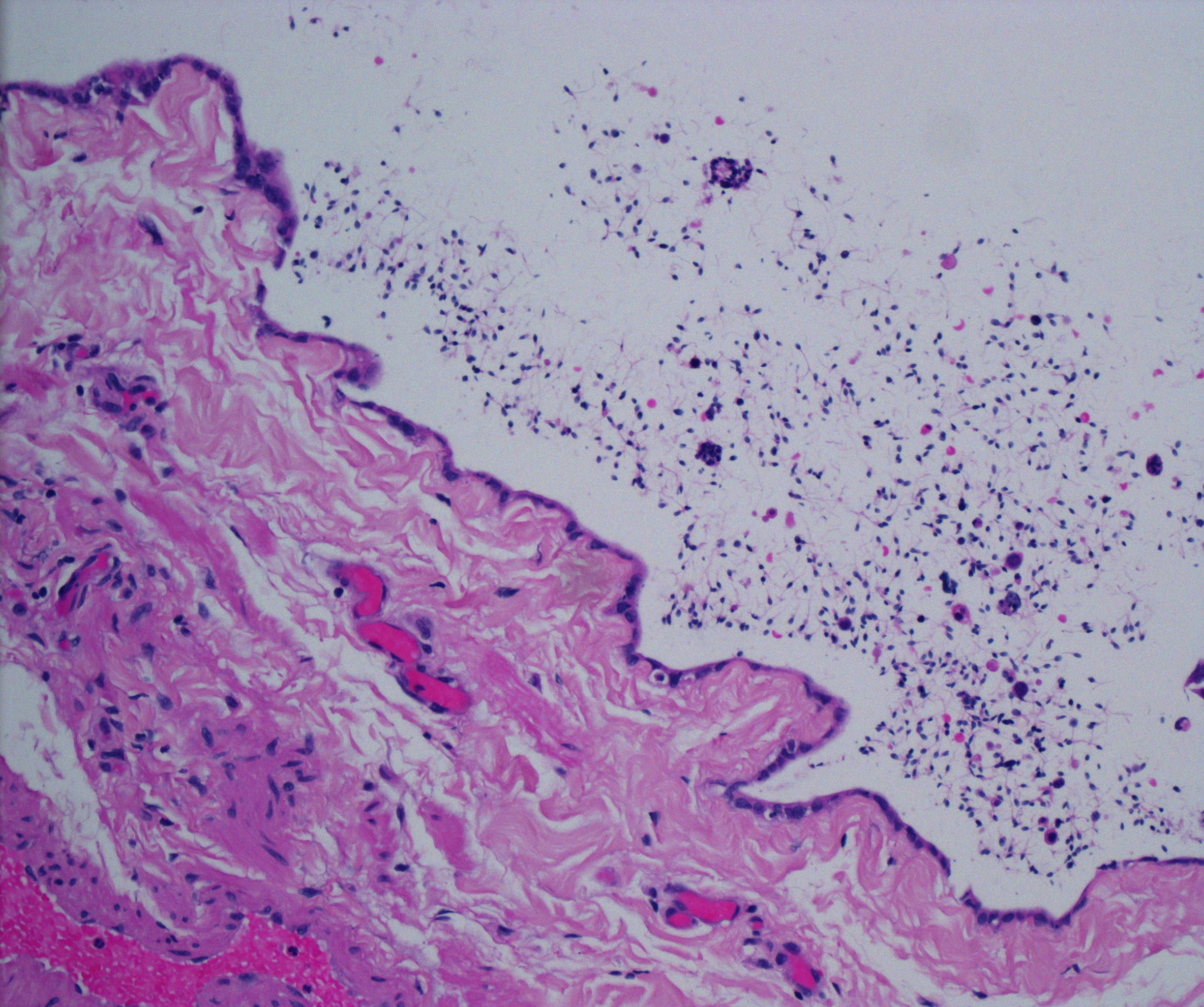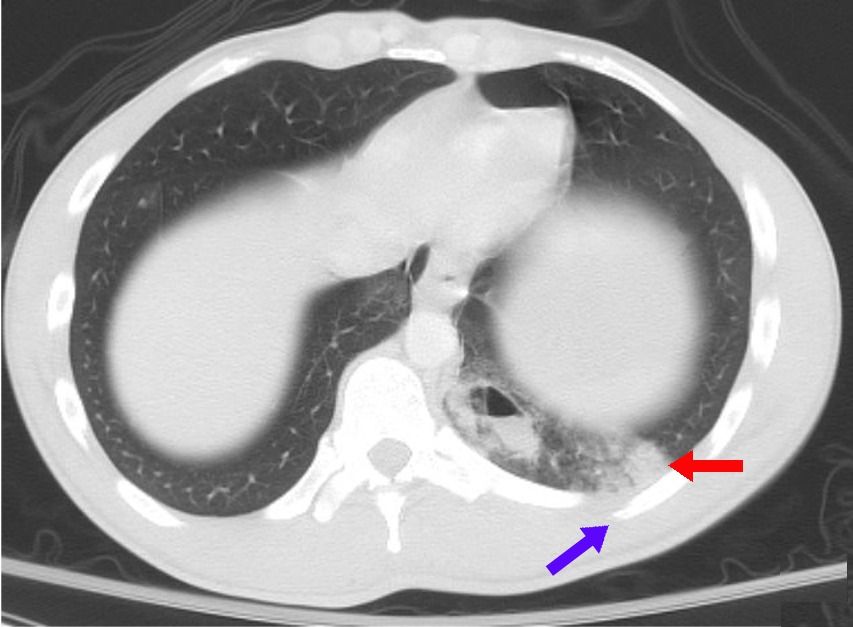|
Spermatocele
Spermatocele is a fluid-filled cyst that develops at the top of the testicle of the epididymis. The fluid is usually a clear or milky white color and may contain sperm. Spermatoceles are typically filled with spermatozoa and they can vary in size from several millimeters to many centimeters. Small spermatoceles are relatively common, occurring in an estimated 30 percent of males. They are generally not painful. However, some people may experience discomfort such as a dull pain in the scrotum from larger spermatoceles. They are not cancerous, nor do they cause an increased risk of testicular cancer. Additionally, unlike varicoceles, they do not reduce fertility. History "Spermatocele" is originally derived from the ''Greek'' term ''spermatos'' (sperm) and ''kele'' (cavity or mass). Oftentimes, "epididymal cyst" has been used interchangeably with "spermatocele." However, it is important to note their differences. Epididymal cysts may appear anywhere along or within the epididymis ... [...More Info...] [...Related Items...] OR: [Wikipedia] [Google] [Baidu] |
Spermatocelectomy
A spermatocelectomy is a surgical procedure performed to remove a spermatocele by separating it from the epididymis. The patient is given an anesthetic in the groin and a small incision is made into the scrotum The scrotum or scrotal sac is an anatomical male reproductive structure located at the base of the penis that consists of a suspended dual-chambered sac of skin and smooth muscle. It is present in most terrestrial male mammals. The scrotum co .... The surgeon pulls the testicle and epididymis to the incision and separates the spermatocele by tying it off with a suture. The surgeon then removes it, and stitches up the area. References Male genital surgery {{surgery-stub ... [...More Info...] [...Related Items...] OR: [Wikipedia] [Google] [Baidu] |
Scrotum
The scrotum or scrotal sac is an anatomical male reproductive structure located at the base of the penis that consists of a suspended dual-chambered sac of skin and smooth muscle. It is present in most terrestrial male mammals. The scrotum contains the external spermatic fascia, testes, epididymis, and ductus deferens. It is a distention of the perineum and carries some abdominal tissues into its cavity including the testicular artery, testicular vein, and pampiniform plexus. The perineal raphe is a small, vertical, slightly raised ridge of scrotal skin under which is found the scrotal septum. It appears as a thin longitudinal line that runs front to back over the entire scrotum. In humans and some other mammals the scrotum becomes covered with pubic hair at puberty. The scrotum will usually tighten during penile erection and when exposed to cold temperatures. One testis is typically lower than the other to avoid compression in the event of an impact. The scrotum is bio ... [...More Info...] [...Related Items...] OR: [Wikipedia] [Google] [Baidu] |
Urology
Urology (from Greek οὖρον ''ouron'' "urine" and '' -logia'' "study of"), also known as genitourinary surgery, is the branch of medicine that focuses on surgical and medical diseases of the urinary-tract system and the reproductive organs. Organs under the domain of urology include the kidneys, adrenal glands, ureters, urinary bladder, urethra, and the male reproductive organs ( testes, epididymis, vas deferens, seminal vesicles, prostate, and penis). The urinary and reproductive tracts are closely linked, and disorders of one often affect the other. Thus a major spectrum of the conditions managed in urology exists under the domain of genitourinary disorders. Urology combines the management of medical (i.e., non-surgical) conditions, such as urinary-tract infections and benign prostatic hyperplasia, with the management of surgical conditions such as bladder or prostate cancer, kidney stones, congenital abnormalities, traumatic injury, and stress incontinence ... [...More Info...] [...Related Items...] OR: [Wikipedia] [Google] [Baidu] |
Transillumination
Transillumination is the technique of sample illumination by transmission of light through the sample. Transillumination is used in a variety of methods of imaging. Microscopy In microscopy transillumination refers to the illumination of a sample by transmitted light. In its most basic form it generates a bright field image, and is commonly used with transillumination techniques such as phase contrast and differential interference contrast microscopy. Medicine In medicine transillumination generally refers to the transmission of light through tissues of the body. A common example is the transmission of light through fingers, producing a red glow due to red blood cells absorbing other wavelengths of light. Organs analysed include the sinuses, the breasts and the testes. It is widely used by pediatricians to shine light in bodies of infants and observe the amount of scattered light. Since their skeleton is not fully calcified, light can easily penetrate tissues. Common examples of ... [...More Info...] [...Related Items...] OR: [Wikipedia] [Google] [Baidu] |
Human Male Reproductive System En
Humans (''Homo sapiens'') are the most abundant and widespread species of primate, characterized by bipedalism and exceptional cognitive skills due to a large and complex brain. This has enabled the development of advanced tools, culture, and language. Humans are highly social and tend to live in complex social structures composed of many cooperating and competing groups, from families and kinship networks to political states. Social interactions between humans have established a wide variety of values, social norms, and rituals, which bolster human society. Its intelligence and its desire to understand and influence the environment and to explain and manipulate phenomena have motivated humanity's development of science, philosophy, mythology, religion, and other fields of study. Although some scientists equate the term ''humans'' with all members of the genus ''Homo'', in common usage, it generally refers to ''Homo sapiens'', the only extant member. Anatomically modern h ... [...More Info...] [...Related Items...] OR: [Wikipedia] [Google] [Baidu] |
Anesthesia
Anesthesia is a state of controlled, temporary loss of sensation or awareness that is induced for medical or veterinary purposes. It may include some or all of analgesia (relief from or prevention of pain), paralysis (muscle relaxation), amnesia (loss of memory), and unconsciousness. An individual under the effects of anesthetic drugs is referred to as being anesthetized. Anesthesia enables the painless performance of procedures that would otherwise cause severe or intolerable pain in a non-anesthetized individual, or would otherwise be technically unfeasible. Three broad categories of anesthesia exist: * General anesthesia suppresses central nervous system activity and results in unconsciousness and total lack of sensation, using either injected or inhaled drugs. * Sedation suppresses the central nervous system to a lesser degree, inhibiting both anxiety and creation of long-term memories without resulting in unconsciousness. * Regional and local anesthesia, which blo ... [...More Info...] [...Related Items...] OR: [Wikipedia] [Google] [Baidu] |
Sclerotherapy
Sclerotherapy (the word reflects the Greek ''skleros'', meaning ''hard'') is a procedure used to treat blood vessel malformations (vascular malformations) and also malformations of the lymphatic system. A medicine is injected into the vessels, which makes them shrink. It is used for children and young adults with vascular or lymphatic malformations. In adults, sclerotherapy is often used to treat spider veins, smaller varicose veins, hemorrhoids,William R. Finkelmeier, Sclerotherapy, Ch. 12, ACS Surgery: Principles & Practice, 2004, WebMD (hardcover book) and hydroceles.Darren T Beiko, Aspiration and Sclerotherapy versus hydrocelectomy for treatment of hydroceles, Urology Vol 61, Issue 4 (Apr 2003) Sclerotherapy is one method (along with surgery, radiofrequency, and laser ablation) for the treatment of spider veins, occasionally varicose veins, and venous malformations. In ultrasound-guided sclerotherapy, ultrasound is used to visualize the underlying vein so the physician can d ... [...More Info...] [...Related Items...] OR: [Wikipedia] [Google] [Baidu] |
Suction (medicine)
In medicine, devices are sometimes necessary to create suction. Suction may be used to clear the airway of blood, saliva, vomit, or other secretions so that a patient may breathe. Suctioning can prevent pulmonary aspiration, which can lead to lung infections. In pulmonary hygiene, suction is used to remove fluids from the airways, to facilitate breathing and prevent growth of microorganisms. Small suction-providing devices are often called aspirators. In surgery suction can be used to remove blood from the area being operated on to allow surgeons to view and work on the area. Suction may also be used to remove blood that has built up within the skull after an intracranial hemorrhage. Suction devices may be mechanical hand pumps or battery or electrically operated mechanisms. In many hospitals A hospital is a health care institution providing patient treatment with specialized health science and auxiliary healthcare staff and medical equipment. The best-known type ... [...More Info...] [...Related Items...] OR: [Wikipedia] [Google] [Baidu] |
Antibiotic
An antibiotic is a type of antimicrobial substance active against bacteria. It is the most important type of antibacterial agent for fighting pathogenic bacteria, bacterial infections, and antibiotic medications are widely used in the therapy, treatment and antibiotic prophylaxis, prevention of such infections. They may either bactericide, kill or bacteriostatic agent, inhibit the growth of bacteria. A limited number of antibiotics also possess antiprotozoal activity. Antibiotics are not effective against viruses such as the common cold or influenza; drugs which inhibit viruses are termed antiviral drugs or antivirals rather than antibiotics. Sometimes, the term ''antibiotic''—literally "opposing life", from the Greek language, Greek roots ἀντι ''anti'', "against" and βίος ''bios'', "life"—is broadly used to refer to any substance used against microbes, but in the usual medical usage, antibiotics (such as penicillin) are those produced naturally (by one microorgani ... [...More Info...] [...Related Items...] OR: [Wikipedia] [Google] [Baidu] |
Asymptomatic
In medicine, any disease is classified asymptomatic if a patient tests as carrier for a disease or infection but experiences no symptoms. Whenever a medical condition fails to show noticeable symptoms after a diagnosis it might be considered asymptomatic. Infections of this kind are usually called subclinical infections. Diseases such as mental illnesses or psychosomatic conditions are considered subclinical if they present some individual symptoms but not all those normally required for a clinical diagnosis. The term clinically silent is also found. Producing only a few, mild symptoms, disease is paucisymptomatic. Symptoms appearing later, after an asymptomatic incubation period, mean a pre-symptomatic period has existed. Importance Knowing that a condition is asymptomatic is important because: * It may develop symptoms later and only then require treatment. * It may resolve itself or become benign. * It may be contagious, and the contribution of asymptomatic and pre-sympto ... [...More Info...] [...Related Items...] OR: [Wikipedia] [Google] [Baidu] |
Edema
Edema, also spelled oedema, and also known as fluid retention, dropsy, hydropsy and swelling, is the build-up of fluid in the body's tissue. Most commonly, the legs or arms are affected. Symptoms may include skin which feels tight, the area may feel heavy, and joint stiffness. Other symptoms depend on the underlying cause. Causes may include venous insufficiency, heart failure, kidney problems, low protein levels, liver problems, deep vein thrombosis, infections, angioedema, certain medications, and lymphedema. It may also occur after prolonged sitting or standing and during menstruation or pregnancy. The condition is more concerning if it starts suddenly, or pain or shortness of breath is present. Treatment depends on the underlying cause. If the underlying mechanism involves sodium retention, decreased salt intake and a diuretic may be used. Elevating the legs and support stockings may be useful for edema of the legs. Older people are more commonly affected. The wo ... [...More Info...] [...Related Items...] OR: [Wikipedia] [Google] [Baidu] |






